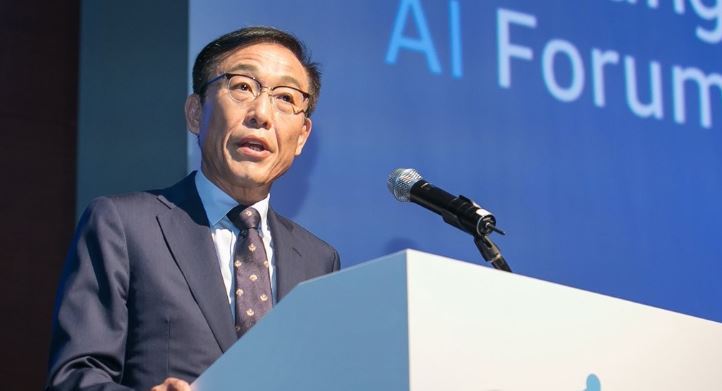LAS VEGAS -- The memory chip market is starting to show signs of improving, leaving Samsung Electronics to deliberate carefully on the timing of the launch of its second memory chip plant in Pyeongtaek, Gyeonggi Province, according to Kim Ki-nam, vice chairman of the tech giant’s semiconductor business on Tuesday.
“There are signs that make us believe the market is recovering,” the vice chairman told The Korea Herald in Las Vegas at Consumer Electronics Show 2020. “However, it is difficult to predict how much the market would recover or which factors would play a role.”
 |
Kim Ki-nam (Yonhap) |
The chipmaker is nearing completion of its second fabrication line for memory chips on a lot about the size of 400 football stadiums, with plans to start operations this year.
According to a report by the Hana Institute of Finance, memory chip prices are likely to achieve stability during the first quarter and recover in the second quarter.
The price of the most widely used 8-gigabit DDR4 rose from $2.81 on average in December to $3.12 as of Tuesday. DRAM prices had fallen continually from October 2018 through July of last year.
Depending on the signs in the market, Samsung may soon make a decision about when to kick-start its second memory chip plant in Pyeongtaek, according to Kim.
“We will decide in accordance with changing market conditions and our schedule (for businesses),” he said.
Regarding the possibility of the second line churning out cutting-edge NAND flash chips, Kim said, “The decision will also depend on market conditions.”
Unlike DRAM prices, NAND flash chip prices have been on the rise since May, posting a 2.55 percent on-month increase for 128 gigabit multilevel-cell devices last month.
Samsung Electronics’ semiconductor performance is expected to experience a rebound within the first half of this year, ending last year’s downturn, according to a preliminary earnings report from Wednesday.
Samsung earlier in the day announced it had posted 59 trillion won ($50.20 billion) in sales and 7.1 trillion won in operating profit in the fourth quarter of 2019.
The company’s sales and operating profit dropped 0.46 percent and 34.26 percent compared with a year earlier due to lower memory demand and falling prices.
Operating profit declined by 52.95 percent to 27.71 trillion won last year from 2018, while revenue dropped 5.85 percent to 229.52 trillion won.
It was the lowest operating profit since 2015, and the lowest revenue since 2016.
The lackluster performance resulted from a fall in memory chip prices that started in the fourth quarter of 2018, as well as from intense smartphone competition worldwide.
Market observers say the situation will start to pick up as early as the first quarter of this year, noting that the company’s fourth-quarter earnings estimate hovered slightly above market expectations.
While the performance of each division is not disclosed in a preliminary earnings report, operating profit in the semiconductor sector is said to be around 2.9 trillion won to 3.2 trillion won.
The semiconductor industry is showing signs of recovery, while demand for new smartphones is rebounding due to the introduction of 5G service and new foldable gadgets, market watchers say.
Some analysts estimate that Samsung could see its operating profit for this year rise by as much as 40 percent.
“With DRAM prices recovering from the first quarter, the business will start to show improvements from the second quarter,” said Yoo Jong-woo, an analyst from Korea Investment & Securities.
By Song Su-hyun (
song@heraldcorp.com)
Korea Herald correspondent








